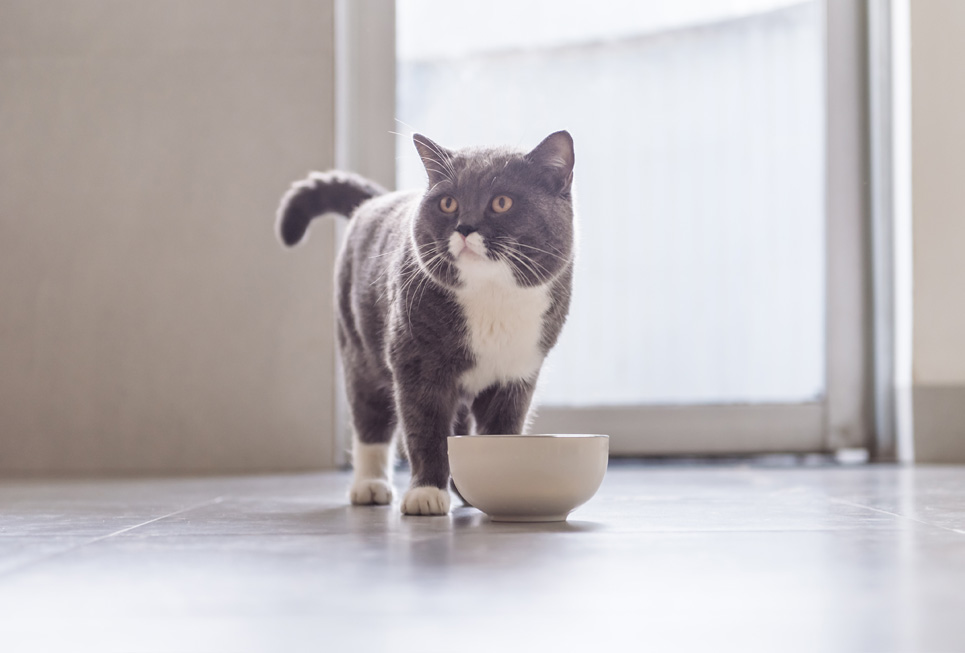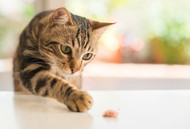The Fussy Eater
29th Aug 2023

“My cat is such a fussy eater”, ring any bells? It is common knowledge to people that cats can be extremely difficult to please when it comes to feeding. What is the cause of this? Is there really such a thing as a fussy eater? We are going to look into some reasons why you might find it a bit hard to find the food that hits the spot and makes them love you that much more for giving it to them!
Cats are programmed to kill and eat fresh meat. Even after thousands of years of being domesticated, they have evolved very little and it is still unnatural for them to have their food served to them. This is the reason their senses are so heightened (specifically their sense of smell), to protect themselves from eating spoiled or rotten foods. If a cat is in the wild, it would not be so picky because it would know exactly what it is having and that it is as fresh as possible, since it would be forced to hunt for its meal. Due to the fight or flight concept being taken from these animals and them knowing they will not starve, they develop these “particular tastes” which is why we then label our beloved cats as “fussy eaters”. In other words, they are not fussy, they know what they want, and even more so, what they need.
Dogs, unlike cats, are considered more as scavengers, due to the way they have evolved. Therefore, they have a tendency to eat whatever is put in front of them. This is not the case with cats. They have very specific dietary requirements.

Aside from sheer survival instinct, there are other reasons your furry friend could be considered a fussy eater. The almighty cat is always going to be a creature of habit so you can learn its ways and preferences in the household via observation. They take comfort in familiarity. Like some of us humans, they have a preference in where they are going to eat, and what. We might always choose the same curry spot on a Friday to order out of and place the exact same order because we know it and love it. It is the same with cats. You will learn where he or she loves to enjoy their meal (hopefully, their delicious PurrForm!) Once you have achieved that, you know to always feed them in the same place, at around the same time and the same amount. That is half the battle.
Cats also like their food to smell & taste the same as previous meals. Even the texture is very important. This is why at PurrForm our ingredients are carefully selected from a small number of suppliers and our products are made to specially prepared recipes to ensure that the smell, taste and texture remain the same, batch after batch.
However, these factors can also explain why it may be difficult to transition a cat from one type of food to another, such as dry to wet, or wet food to raw. A cat can usually be transitioned but it can take time and patience. Trying to rush this, can be stressful for the cat parent, as well as the cat.

Any of the above changes in a cat’s food can be enough to cause it to reject its food. It is also important to realise that cats predominantly use their sense of smell to establish if their food is fresh. Their nose is an essential tool in pre-tasting a potential meal. Even leaving a cat’s usual diet out for too long can determine whether it wants to eat it, as this may mean it no longer smells or tastes the same, or may become too dry.
The temperature of the food must also be considered. Food that is too cold, or too warm can be off-putting and uncomfortable for a cat’s stomach and it won’t release enticing aromas. Ideally, a cat likes the food at room temperature, to mimic that of its natural prey in the wild.
Another factor is safety. As in the wild, they need to feel safe whilst eating. If they are surrounded by too many people or strangers, or even other pets, it could put the cat off from eating. Think of yourself at a restaurant, you do not want to be surrounded by running children, or a live band 1 meter away from you. Instead, you want to enjoy a meal in a comfortable place, where you do not feel rushed or have too many distractions. Comfort is important when it comes to eating food. For us, and for them alike. So, be sure to place their food in a safe and comfortable place for them. Likewise, if you have more than one cat, try to feed them apart, as there may be tension between them, or one can intimidate another. Cats can have a social structure but are not usually social eaters, the way we are.

We love eating nearly EVERYTHING! Our kitties, on the other hand, need species-appropriate foods. They need food that is going to complement their breed, age, weight, and medical history. Of course, it is a good idea to occasionally try to switch the flavour or protein the cats are being fed if you notice they are slowly stopping to eat their food, but if you switch from one protein to another, you must remember that they know what is best for them. You will struggle to switch proteins if your cat has been eating one flavour their entire life. Simply put, transitioning flavours is highly recommended, but you need to be careful about how you do it and be patient. They will let you know what they want.
Be careful also to not feed your cat too many treats between meals. Treats should be just that, an occasional offering. In the same way that we can spoil our appetite if we eat between meals, it can be the same with an animal.
Something some cat owners may not consider is the bowl that the food is being served in. You do not want to put their food in a dish that is too deep for them to eat comfortably. Cats don’t really like their whiskers to touch the sides of the bowl. The food needs to be accessible, especially if your cat is experiencing any sort of health issues which would make it difficult to bend into the bowl. Most cat food dishes appeal more to humans than to the cats themselves. Hygiene is also extremely important, so you want to make sure that the bowl is completely clean and never ‘top-up’ a bowl with more food. A ‘stale’ smell will be off-putting to your cat, so any uneaten food must be disposed of.

Finally, if your cat has always eaten the same food and then suddenly decided that it does not want to eat it any longer, there are some things you can consider before panicking. It might simply have gotten bored of the same taste, so you can try to vary the flavour. However, try to stick to the same meat type, for example, if your cat likes fish, stick to fish, if it liked chicken, try quail or turkey instead, etc. Has there been an addition to the family, such as another animal in the household? This could be causing your cat some stress which will deter it from eating. Your cat could also be put off its food if you have tried to ‘hide’ any medication in the food, as it may then associate further meals with a bitter or unsavoury flavour. Lastly, if your cat seems to be off its food altogether, there might be an underlying issue, which would then be recommended for you to take your cat to the vet, to ensure everything is alright.
Click here to start trying Purrform raw cat food!
